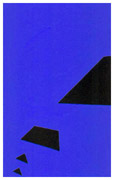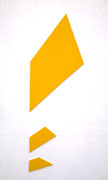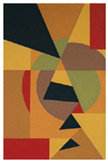Pontus Ersgard was born in Sweden in1971. He moved to Los Angeles in1990 where he attended the Art Centre College of Design. His experience includes jewellery smith, set design and visual FX design for feature-film.
In 1996 he moved back to Europe where he began exhibiting Fine Art. In 1998 he took a respite and spent six months on horseback in the Montana Wilderness. Full of inspiration he returned and began work on his Los Angeles exhibition hosted by Cindy Crawford in 1999. He currently resides in England and his work is represented in England, France, Sweden and the United States.
I have always been fascinated by constructive art in the tradition of Mondrian, Kandinsky and Klein. I am intrigued by the concept that art should not be an imitation of reality but an original in all aspects. My works of art have no counterpart in the real world. It exists solely in my mind and is created only with the two original constituents of true art - color and shape.
During the last decade I have worked intently with developing my own constructive concept of art. Although my art does not correspond to objects in the external world, I try to reach out to the beholder and invite him or her to share an experience of illusion. My aim is to create this experience of illusion with my "Scala Concept", using either minimal colors and space or a multitude of colors .
The Scala Concept is based on a three dimensional theory, creating an illusion of depth and space using color and form on the two dimensional plane. "Scala" is Italian for scale which in itself means an ordered series of units or quantities relative to size or extent, but "scala" also means steps or stairs and I use the shape of steps to express the three dimensional theory and to emphasize the illusion of boundlessness. By focusing on the illusion of steps the viewer can create a three dimensional sensation, therefore the title "Scala".
However, a work of art exists only when viewed by an observer, and here is, in my opinion, the great charm of constructive art, because the artwork invites the observer not only to share an experience of illusion but the observer is free to fill this experience with whatever images or feeling that may originate from the experience.
Sometimes I get the question what my art means or what I'm trying to express with my art. I then always return the question with "What do you think?". The answer to my question is never the same. It could be anything from loneliness to exhilaration, from coldness to warmth, from void and space to plain color and shape. But whatever the answer, my response is always the same : "That is exactly what I want to express with my art".
Pontus H. Ersgard

|
|
|
|
|
|
|
|
© Melt Magazine 2001
|








